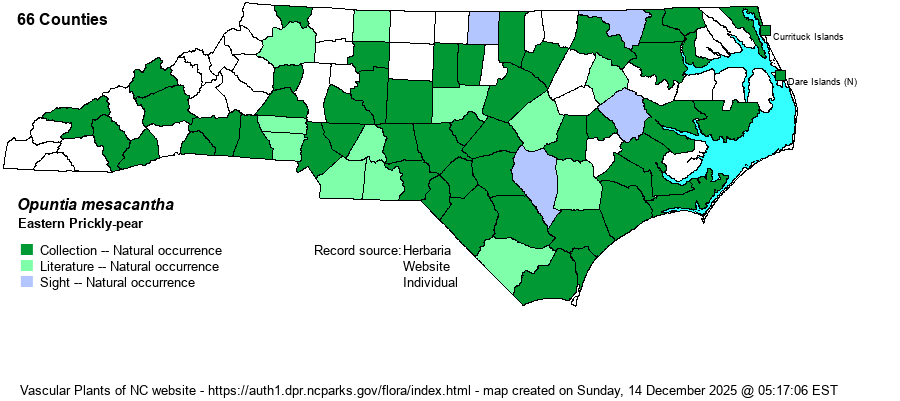| Author | Rafinesque | |
| Distribution | Occurs over most of the Coastal Plain and Piedmont, but in the Mountains only in a few counties at low elevation. Likely present in all counties east of the Mountains.
Present in the Southeastern part of the country, north to NJ, and south to the Gulf Coast. The BONAP map includes additional taxa (e.g., O. humifusa).
| |
| Abundance | Infrequent to fairly common over most of the Coastal Plain and Piedmont, at least in its somewhat restricted habitats; scarce in the northwestern Piedmont except on some monadnocks in the Brushy Mountains. Rare to very uncommon in the lower Mountains. Absent, apparently, in the northern mountains, except for Alleghany County so far. | |
| Habitat | This species is characteristic of sandy or rocky soil, especially favoring deep sands of low dunes, sandy rims of Carolina bays, and sandhills. In the Piedmont and Mountains it is most often found around granitic flatrocks and granitic domes/monadnocks. |
| Phenology | Blooms in May and June, and occasionally later; fruits from August to October. | |
| Identification | Everyone knows what a “cactus” looks like, and this is the primary cactus species found in the East. It has very fleshy, succulent, and prostrate stems that are jointed and composed of pale green and broadly rounded or elliptic “pads” that grow to about 4 inches long. There are several such fleshy pads on each plant. A few widely scattered spines, to about 1-inch long, are usually present, though it is not a heavily armed plant. Technically, the leaves are quite small, much less than an inch long, and they quickly are shed. Plants are especially attractive in bloom, when the one to several large yellow flowers, often 2 inches or more across, appear in summer. The other native species of cactus (O. drummondii) in the state is much smaller and has numerous long spines; it grows essentially along the coast. | |
| Taxonomic Comments | There has been considerable re-naming of this species over the decades. It was listed as Opuntia compressa in RAB (1968), but it has been named as O. humifusa, O. mesacantha, and perhaps others in recent years. Not only that, the species has recently been “carved” into several species, though O. mesacantha is the one that includes NC. In fact, Weakley (2018) indicates that O. humifusa is not present in NC, but ranges essentially north of the state, with O. mesacantha being a more southerly taxon.
| |
| Other Common Name(s) | Devil’s-tongue, Low Prickly-pear | |
| State Rank | S5 | |
| Global Rank | G5 | |
| State Status | | |
| US Status | | |
| USACE-agcp | | |
| USACE-emp | | |

